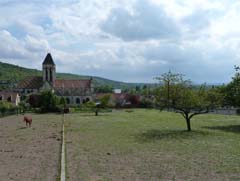Prochain point : lat="49.06475" lon="1.704020005"

A village famous for Impressionist painters
The church dominates the village
Vetheuil, which used to be spelt Vétheuille or Véteuil, comes from the Latin vetolium or villa. The village, located in the bottom of the valley, spreads up the slopes to the plateau. The old buildings face the Seine, oriented east / west and the houses are often terraced, built along narrow lanes. The more recent buildings are scattered on the hillside.
Notre Dame Church has an important place in the landscape, due to its location overlooking Vetheuil, its size and polychrome roof patterns. It was built during the second half of the twelfth century on the foundations of an older building (eleventh century). The chevet, which includes the chancel and apse, faces east and the main entrance faces west. When it became too small, expansion work was conducted from the thirteenth century and finally completed in the sixteenth century.
The Seine: a major footprint in the landscape
The Seine valley has a thousand-year-old history, shaped by nature and man. The Seine has always been a natural border, but never an insurmountable obstacle. Until the nineteenth century, the river was a moving space whose banks and islands depended on the current, making navigation difficult. But since the early twentieth century, dredging has been used to maintain sufficient depth for barge traffic. Dredging consists of removing the materials or sediment (sand, silt) that accumulate on the riverbed. The dredged material is deposited in the estuary at locations where it promotes stability and water levels in the navigation channel. The Seine is an important trade route. It structures the landscape and the Impressionists were particularly attracted by the different atmospheres it evokes.
Development of activities
In the foreground of this panorama, a large grassed area is dotted with fruit trees. They are the remains of the many cherry, apple, pear and walnut trees once cultivated in the area. They were planted at the edge of the village towards the top of the hill. Over time, Vetheuil had various agricultural crops. In the eighteenth century, viticulture was the main activity. However, in the early twentieth century, the emergence of phylloxera, a disease caused by parasitic aphids, combined with competition from imported wines transported by rail and the inconsistent quality of the local harvest put an end to this crop. As agriculture was abandonned there were fewer cultivated plots, leading to monoculture and the extension of the forest area.





